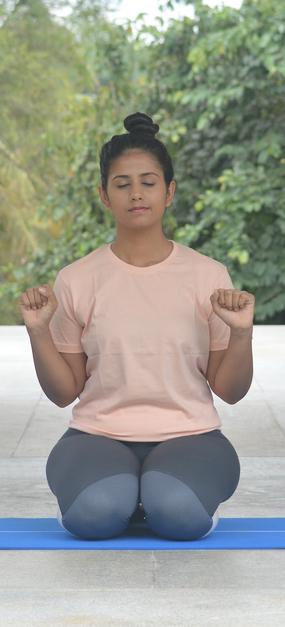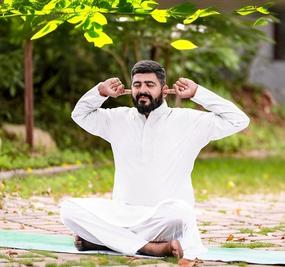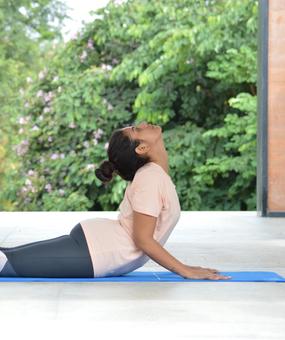In a world defined by stress, sluggish digestion, and a relentless pursuit of clarity, we often overlook the most powerful tool for transformation: our own breath. Kapalbhati, the dynamic yogic practice known as the ‘Skull Shining Breath’ 🌟, offers a scientifically validated pathway to detoxify the body, sharpen the mind, and boost energy. From the ancient scriptures of India to modern clinical research, its potent Kapalbhati benefits for respiratory, digestive, and nervous system health are undeniable. If you are seeking a profound yet accessible technique to enhance your well-being, this detailed guide will illuminate the precise steps to do Kapalbhati, its deep philosophical roots, and its transformative impact on your life.
What This Comprehensive Guide Covers:
- The profound ancient wisdom from Hatha Yoga Pradipika and Vedantic philosophy
- 12 scientifically validated health benefits with research citations
- Detailed step-by-step practice instructions with variations
- Advanced techniques and integration strategies
- Therapeutic applications for specific health conditions
- Common mistakes, contraindications, and safety guidelines
- Expert insights on deepening your pranayama practice
- Comprehensive FAQ addressing practitioners’ most common concerns
What Are the Ancient Roots of Kapalbhati Pranayama?
Scriptural Foundations
In the classical Hatha Yoga texts, such as the Hatha Yoga Pradipika (Chapter 2, Verse 35) and the Gheranda Samhita (Chapter 1, Verse 54), Kapalbhati is revered as the sixth and final of the Shatkarmas (Six Purification Techniques).
The Shatkarmas are foundational practices designed to cleanse the physical body of toxins and imbalances, making it a fit vessel for higher yogic practices like Pranayama and Dhyana (Meditation).
- Hatha Yoga Pradipika: Explicitly states that Kapalbhati “removes all impurities” and imbalances, particularly those related to the Kapha dosha (phlegm/mucus), which is associated with lethargy and dullness.
- Gheranda Samhita: Details three specific types: Vatakrama (air-based, similar to the common practice), Vyutkrama (water snorting/expelling), and Shitkrama (expelling water through the nose after taking it in through the mouth). This shows its primary function was for nasal and respiratory purification—a deep cleaning of the head region.
This ancient emphasis on detoxification and purification is what connects the practice directly to the ‘shining’ or illumination of the mind. By clearing the energetic channels (nadis), the flow of Prana is enhanced, leading to greater mental clarity and vitality. These Shatkriyas are
- Neti (nasal cleansing)
- Dhauti (digestive tract cleansing)
- Nauli (abdominal churning)
- Basti (yogic enema)
- Kapalbhati (frontal brain purification)
- Trataka (concentrated gazing)
The Hatha Yoga Pradipika (Chapter 2, Verse 35) states: “Kapalabhati removes disorders of phlegm, and therefore the six types of purification are accomplished.”
This wasn’t merely physical cleansing. Ancient yogis understood that physical purity directly influences mental clarity—a principle now validated by psychoneuroimmunology research showing the gut-brain-breath axis influences everything from mood to immunity.
Vedantic Philosophy and Prana
The Upanishads, particularly the Prashna Upanishad, describe prana as the fundamental life force pervading all existence. Kapalbhati works directly with apana vayu (the downward-moving vital energy) to:
- Clear energetic blockages in the nadis (subtle energy channels)
- Activate the manipura chakra (solar plexus energy center) associated with willpower and transformation
- Balance ida and pingala nadis, harmonizing left-right brain hemispheres
Patanjali’s Yoga Sutras (Chapter 2, Sutras 49-53) position pranayama as the fourth limb of Ashtanga Yoga, bridging the external practices (asana) with internal practices (pratyahara, dharana, dhyana). While Kapalbhati isn’t explicitly pranayama, the principle is clear: mastering breath control is essential for mastering the mind.
Modern Relevance
Today’s global context presents unprecedented challenges that make a purification technique like Kapalabhati uniquely relevant. We face:
- Air Pollution: 99% of the global population breathes air that exceeds the World Health Organization’s (WHO) strict air quality guidelines, significantly increasing the risk of respiratory and other diseases (WHO, latest data). Kapalabhati serves as a mechanical cleansing of the respiratory passages.
- Chronic Stress & Mental Health: Depression and anxiety disorders are estimated to cost the global economy US$1 trillion annually in lost productivity alone (WHO/ILO). The invigorating, clarifying effect of Kapalabhati on the mind can directly combat lethargy and mental fog.
- Respiratory Resilience: The recent COVID-19 pandemic profoundly underscored the critical importance of respiratory health, lung capacity, and immune function, which Kapalabhati is traditionally believed to enhance.
- Digital Overload & Attention Deficit: The average American checks their phone an estimated 205 times per day, fragmenting attention and increasing mental distraction. Kapalabhati is a focused, rhythmic practice that trains concentration and clears the mental static created by constant sensory input.
Kapalabhati directly addresses these modern ailments through mechanisms the ancients understood intuitively (sˊuddhi – purification) and which contemporary science confirms: improved oxygenation, diaphragm strengthening, and nervous system invigoration.
Comprehensive Benefits of Kapalbhati
1. Respiratory System Optimization 🌬️
Kapalbhati’s core mechanism is the forceful, active exhalation, which is the reverse of normal breathing. This active expulsion significantly reduces the residual volume—the stale, carbon dioxide-rich air that often remains trapped in the lungs. By making more room for fresh air, it enhances the intake of oxygenated air during the subsequent passive inhalation. This action strengthens the diaphragm and intercostal muscles and has been shown in studies to improve measures like Forced Vital Capacity (FVC) and Peak Expiratory Flow Rate (PEFR). For urban dwellers, this acts as crucial daily respiratory hygiene, helping to mobilize and clear mucus and irritants from the bronchial passages.
2. Digestive System Activation & Metabolic Boost 🔥
The rapid, rhythmic contraction of the abdominal muscles creates an intense, dynamic internal pressure. This action provides a deep, rhythmic visceral massage to the key abdominal organs: the liver, spleen, pancreas, and gastrointestinal tract. In Ayurvedic terms, Kapalbhati directly stimulates Jatharagni (gastric fire) and Samana Vayu (digestive sub-prana), which elevates the metabolic rate and Pitta. This metabolic boost aids in the mobilization of abdominal fat and assists in better regulation of blood sugar levels. Furthermore, it improves peristalsis (gut motility), relieving symptoms like bloating and constipation.
3. Cognitive Enhancement and Mental Clarity 🧠
As the “Skull Shining Breath,” this practice is famous for its effect on the brain. It maximizes cerebral oxygenation and blood flow to the brain, which is vital since the organ consumes about 20% of the body’s total oxygen. This increased supply and the resultant brain activation—particularly in the prefrontal cortex—leads to enhanced sustained attention, sharper working memory, and reduced mental fog. The technique is known to promote the production of alpha brain waves, inducing a state of relaxed alertness that prepares the mind perfectly for deep concentration or meditation.
4. Stress Reduction and Emotional Regulation 🧘
The conscious control over the breath directly intervenes in the body’s stress response. Research demonstrates that regular practice leads to a reduction in the stress hormone cortisol and an increase in GABA (the main calming neurotransmitter). This helps shift the Autonomic Nervous System away from the sympathetic overdrive (fight-or-flight) toward enhanced parasympathetic tone (rest-and-digest). This balance is reflected in improved Heart Rate Variability (HRV), a key marker of emotional resilience, offering a non-pharmacological route to managing anxiety.
5. Cardiovascular Health ❤️
The rhythmic action in the abdomen influences blood flow and pressure. By reducing sympathetic nervous system activity, Kapalbhati helps to lower systolic blood pressure and improves endothelial function (the health of blood vessel linings). The enhanced circulation aids in better blood purification, contributes to improved lipid profiles, and reduces oxidative stress on cardiac tissue.
6. Metabolic and Weight Management Support ⚖️
Kapalbhati contributes to a healthy metabolism by supporting the digestive fire. The vigorous muscle engagement generates internal heat, promoting thermogenesis and assisting in the mobilization of abdominal fat. Furthermore, by regulating the stress hormone cortisol and providing stimulation to the thyroid gland, it supports overall hormonal balance essential for sustainable weight and metabolism management.
7. Detoxification at a Cellular Level 💧
This practice is one of the most effective yogic purifications (sˊuddhi). The forceful exhalation eliminates significantly more carbon dioxide (a major cellular waste product) than normal breathing. Crucially, the rhythmic abdominal pumping actively massages and pumps the lymph fluid, which depends on muscle movement to circulate and remove cellular waste and toxins from the body.
8. Immune System Enhancement 🛡️
The overall physiological benefits converge to bolster the immune system. By consistently lowering high cortisol levels (a known immune suppressant), the body’s natural defenses are strengthened. The technique is also associated with an increase in natural killer cell activity, a key component of the innate immune response, as confirmed by immunology research.
9. Skin Radiance ✨
Often called the “Skull Shining Breath” for a reason, the practice dramatically increases microcirculation to the face and head. This enhanced blood flow provides better nourishment and oxygenation to the skin cells, supporting processes like collagen synthesis and resulting in a healthy, natural, and radiant complexion.
10. Hormonal Balance 🌸
The intense movement at the core directly and indirectly stimulates various endocrine glands. The energy focus at the manipura chakra (solar plexus) can aid in stimulating the adrenal glands and pancreas. When combined with practices like Jalandhara Bandha (chin lock), it can also have a balancing effect on the thyroid gland, promoting overall hormonal regulation.
11. Sinus and Allergy Relief 👃
Kapalbhati’s traditional classification as a Shatkarma is partly due to its effectiveness in clearing the upper respiratory tract. It is specifically recommended for removing kapha doṣa (mucus and phlegm). The forceful clearing of the nasal passages and sinuses reduces chronic inflammation and congestion, providing symptomatic relief from seasonal allergies and sinusitis.
12. Energy Amplification and Vitality ⚡
Ultimately, Kapalbhati is a powerful energizing technique. It efficiently activates and circulates prana (life-force energy), channeling it upward to the higher energy centers. This energetic boost helps eliminate lethargy (tamas) and chronic fatigue, promoting a sustained state of vitality and dynamic alertness throughout the day.
How Do You Practice Kapalbhati: Complete Instructions
Preparation Phase
Optimal Conditions:
- Timing: Early morning (5-7 AM) during Brahma Muhurta (optimal prana)
- Environment: Well-ventilated, clean space; comfortable temperature
- Stomach: Empty (3-4 hours post-meal)
- Clothing: Loose, comfortable, breathable fabrics
- Preliminary: 5 minutes gentle stretching or Sukshma Vyayama (subtle exercises)
Sitting Posture Options:
| Posture | Description | Best For |
| Padmasana (Lotus) | Classic cross-legged, feet on opposite thighs | Advanced practitioners with flexible hips |
| Siddhasana (Accomplished) | One heel at perineum, other in front | Meditation focus, energy control |
| Sukhasana (Easy) | Simple cross-legged | Beginners, anyone with knee issues |
| Vajrasana (Thunderbolt) | Kneeling, sitting on heels | Those with lower back discomfort |
| Chair | Feet flat, spine straight | Elderly, mobility limitations |
Key Principle: Spine erect but relaxed, allowing unobstructed prana flow through sushumna nadi (central energy channel).
The Kapalbhati Breath:
- Close eyes gently
- Take 3 deep, calming breaths—inhale completely, exhale completely. Inhale again.
- Exhalation (Active): Contract abdominal muscles sharply, pulling navel inward toward spine. The exhale through nostrils should be forceful, audible, explosive.
- Inhalation (Passive): Immediately release abdominal contraction. Breath returns automatically—do NOT consciously inhale. Abdomen relaxes outward naturally.
- Rhythm: Begin at 1 stroke per second (60/minute). Advanced practitioners may reach 120-140/minute.
Completion:
- After 20-30 strokes, exhale completely
- Inhale deeply through nose, filling lungs completely.
What Are Common Mistakes and How to Avoid Them?
| Mistake | Consequence | Correction |
| Forced inhalation | Chest tension, hyperventilation | Allow passive, automatic inhalation |
| Chest breathing | Reduced effectiveness, neck strain | All movement originates from abdomen |
| Irregular rhythm | Nervous system confusion | Maintain steady, metronomic pace |
| Facial tension | Headaches, eye strain | Keep face relaxed, soft smile |
| Practicing post-meal | Nausea, digestive discomfort | Always empty stomach (3-4 hour gap) |
| Overexertion | Dizziness, exhaustion | Build capacity gradually, listen to body |
| Poor posture | Back pain, restricted breathing | Ensure spine is erect before starting |
Who Should Modify or Avoid Kapalbhati?
Absolute Contraindications:
- Pregnancy (all trimesters)
- Menstruation (gentler practice)
- Abdominal or thoracic surgery (recent 6 months)
- Active hernias (inguinal, umbilical, hiatal)
- Severe cardiovascular disease, recent heart attack
- Uncontrolled high blood pressure (>160/100)
- Epilepsy or seizure disorders
- Detached retina or glaucoma
- Active ulcers (gastric or duodenal)
Relative Contraindications (Practice with Modification):
- Controlled hypertension (reduce intensity)
- Asthma (supervised initial practice)
- Chronic back pain (ensure proper posture support)
Pregnancy Note: During pregnancy, the forceful abdominal contractions can create intra-abdominal pressure inappropriate for the developing fetus. Alternative gentle pranayamas like Nadi Shodhana or Brahmari are safe and beneficial.
How Can Kapalbhati Be Used Therapeutically?
For Respiratory Conditions:
- Asthma Management: Gradual practice strengthens respiratory muscles, reduces attack frequency
- COPD Support: Improves breathing efficiency, quality of life
- Post-COVID Recovery: Rebuilds lung capacity (under medical supervision)
For Digestive Issues:
- IBS: Regulates gut motility, reduces stress-triggered symptoms
- Constipation: Natural peristaltic stimulation
- Bloating: Massages organs, releases trapped gas
For Mental Health:
- Anxiety Disorders: Activates parasympathetic nervous system
- Depression: Increases serotonin and endorphins
- ADHD: Improves attention regulation in adults
Clinical Integration: Progressive healthcare providers now incorporate pranayama into integrative treatment plans. At Sri Sri School of Yoga, students learn these practices with contraindication awareness, preparing them to work safely with diverse populations.
Comprehensive FAQ: Your Questions Answered
Q1: How long before I experience benefits?
Immediate effects include energy boost and mental clarity. Sustained benefits (cardiovascular, digestive, stress resilience) typically emerge within 3-4 weeks of daily practice. Transformation is progressive—consistency matters more than intensity.
Q2: Can I practice Kapalbhati if I have high blood pressure?
If controlled (below 140/90), yes—with modifications: gentler exhalations, fewer strokes (20-30), no breath retention. Always consult your physician first. Uncontrolled hypertension requires medical management before pranayama.
Q3: What’s the difference between Kapalbhati and Bhastrika?
- Kapalbhati: Forceful exhalation, passive inhalation; emphasis on abdominal pump; cleansing focus
- Bhastrika: Forceful both exhalation and inhalation; thoracic breathing; energizing focus
Both are powerful but serve different purposes in a complete pranayama practice.
Q4: Is evening practice acceptable?
Morning is ideal due to clear nadis and empty stomach. If necessary, late afternoon (4-6 PM, pre-dinner) works. Avoid evening/night as the energizing effects may interfere with sleep.
Q5: My nose gets congested during practice—what should I do?
This indicates initial detoxification—mucus mobilization and expulsion. Continue gentle practice; use Jala Neti (saline nasal irrigation) beforehand. Congestion typically resolves within 1-2 weeks as passages clear.
Q6: Can children and teenagers practice Kapalbhati?
Children 12+ can practice with reduced intensity (20-30 strokes) and supervision. Benefits include improved concentration for studies, better emotional regulation, and respiratory health—particularly valuable in our screen-dominated era.
Q7:What if I feel dizzy or lightheaded?
Stop immediately, return to normal breathing. Dizziness indicates hyperventilation (excess CO2 expulsion). Next session: reduce strokes, slow pace, avoid breath retention. Build tolerance gradually.
Q8: Do I need a teacher, or can I learn from videos?
Basics can be learned independently with quality resources. However, subtle nuances—breath rhythm, abdominal engagement depth, energy awareness—are best learned with personalized feedback from an experienced teacher. This prevents injury and accelerates progress.
The Time to Shine is Now:
You have taken the time to understand the deep, authentic science behind Kapalbhati. This profound knowledge is the first step toward true mastery. Are you ready to dive deeper into the complete science of yoga, transform your own life, and become a credible, authentic guide for others?
The Sri Sri School of Yoga Teachers Training Program (SSY TTP) offers you an unparalleled opportunity. Rooted in purity, backed by scientific rigor, and guided by wisdom, the SSY TTP equips you with the unique methodology to teach all eight limbs of yoga effectively, making a real-world impact.








